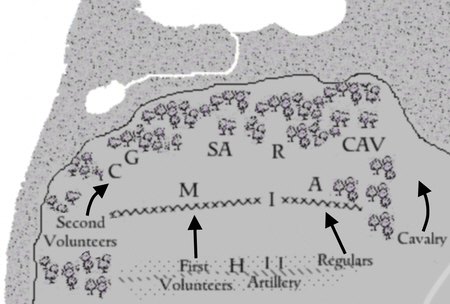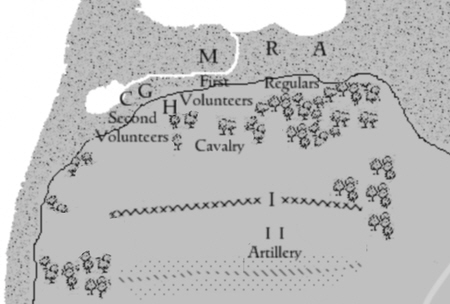 |
The Battle of San Jacinto
in
900 Words
(an excerpt from The Soldiers of San Jacinto)
April 21, 1836 4:00 PM�

4:00 PM, April 21, 1836 � General Houston, atop a dappled�gray, gives the order, �Trail arms! Foward!� Some�900 men, unwashed, underfed, caked with mud and�dressed in rags, begin a long walk through knee-high�grass. They have been pushed to the edge, run from�their homes, their crops and houses burned. They don�t�know whether their families have found safety.�They've�lost kin and good friends at the Alamo and at Goliad.�They want a fight and are about to get it.
At the far left of this parade line is the Second Regiment�of Volunteers, 330 men under Colonel Sherman.�To their right, at the center of the Texian force, is Colonel�Burleson�s First Volunteers, 386 men strong. Next�are the 32 men of Colonel Hockley�s Artillery Corps.�They man two iron canon, six-pounders called the Twin�Sisters, gifts from the people of Cincinnati. To the right�of the artillery are 92 men of the Regular Army under�Lt. Colonel Millard. At the extreme right is the Cavalry,�62 mounted men commanded by Colonel Mirabeau�Lamar, just yesterday a private. All advance in perfect�silence.
4:30 PM

4:30 PM � The Second Volunteers under Sherman,�having traveled swiftly through the oaks on the Texian�left, fire on the surprised men of General Cos� command.�The Battle of San Jacinto has begun. The Mexican�forces return fire, but they are soon on the run. Sherman,�leading the pursuit, is the first to shout, �Remember�the Alamo! Remember Goliad!� The main body of�the Texian forces crest a slight rise. They are 200 yards�from the Mexican breastworks, a four foot barricade of�cut brush, saddles and baggage. Houston, riding thirty�yards in front of the First Regiment, orders, �To the�charge! To the charge!� Musicians strike up a bawdy�march on fife, drum and fiddle. General Castrill�n directs�his canon fire on Lamar�s advancing cavalry. The�Twin Sisters, loaded with cut-up horse shoes, hail hot�metal at the alarmed Mexican troops. A small force advances�on the Texian artillery, but is repulsed.
4:35 PM

4:35 PM � Havoc reigns on the enemy left as the Texian�Cavalry attack their stunned counterparts with slashing�sabers. Burleson�s First Volunteers are upon the breastworks�engaging Matamoros Battalion. To their right�Texian regulars assault Aldama Battalion with equal ferocity.�Stampeding behind the lines, riderless Mexican�horses bring terror to the breastworks defenders, who�now believe they are being attacked from the rear. The�Second Volunteers drive Cos� panicked men rearward�into Colonel Almonte�s Guerrero Regiment, pushing�them all nearly two hundred yards.
4:40 PM

4:40 PM � Almonte attempts to rally any men who�can still be commanded, but it is too late. Matamoros�and Aldama Battalions turn from defense of the breastworks�in wild retreat. The First Volunteers and Texian�Regulars are over the breastworks, pursuing with savage�intent. The resistance at the Mexican canon position�is overcome and the gun seized. Any Mexican cavalry�able to mount up flee toward Harrisburg, Santa Anna�among them.
4:45 PM � Sherman�s Second Volunteers chase Cos and�Almonte�s men into a small bayou to the Texian left.�The First Volunteers force Matamoros Battalion into�the marsh at the rear of the Mexican position and into�Peggy�s Lake. Some try to surrender, pleading for their�lives, crying, �Me no Alamo! Me no la Bahia!� There is�no mercy. Many Texians fire only once and don�t waste�time to reload. They turn their rifles around and swing�them as war clubs, breaking many off at the breach in�the act of shattering a skull. The air is filled with the�acrid smell of gun powder and the stench of feces as�dying men void their bowels.
4:48 PM

4:48 PM � The Battle of San Jacinto is over, but not the�killing. Behind the Texians are the enemy dead. To their�front, in marsh, lake and bayou, those Santanistas still�living try in vain to escape or plead for their lives. The�Texians calmly, but briskly reload, time and again. Each�shot means the end for another of Soldado.
Sundown � A guard is set on the Mexican camp to�keep the men from looting. The spoils are to be divided�among them as war booty. Mexican soldiers who escaped�the slaughter are being rounded up and marched�to the oak stand on Buffalo Bayou from which the Texians�set out barely two and a half hours ago. They will�be held in a pen made of split logs, rope and anything�else that lends itself to the job. The Texians wander back�to camp, singly and in small groups. Some talk about�deeds of the day, others sing songs, laugh and trade�cheers across the prairie. Still others just walk, their�thoughts their own until the end of their days.
If the Alamo is called Texas� Thermopylae, then San�Jacinto is her Agincourt. Of the Texian forces there are�but seven killed. Twenty-nine are wounded, including�General Houston, his ankle shattered by a copper ball�from an escopeta. Of those wounded four will die. The�Mexican dead number 630. The prisoners tally 730, of�which 208 are wounded. The events of this day will�mean perpetual freedom for Texas, as a republic for�now, and in ten years as one of the United States. History�will show that the soldiers of San Jacinto have set�the keystone in the arch of Manifest Destiny.
This essay appears as the preface to The Soldiers of San Jacinto by J.
B. McDonald, a biographical study of the men who risked all so Texas
would be free. If you would like to have a copy for your personal
library, you can order it on this page. You might also consider donating a copy
a high school or college library, as they are budget strapped these
days.
|
|
 |

